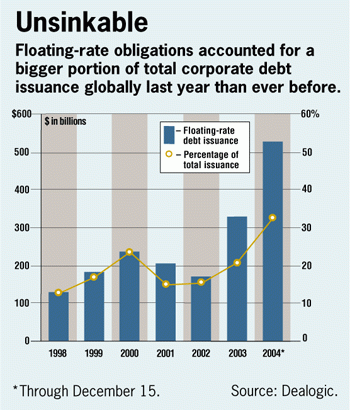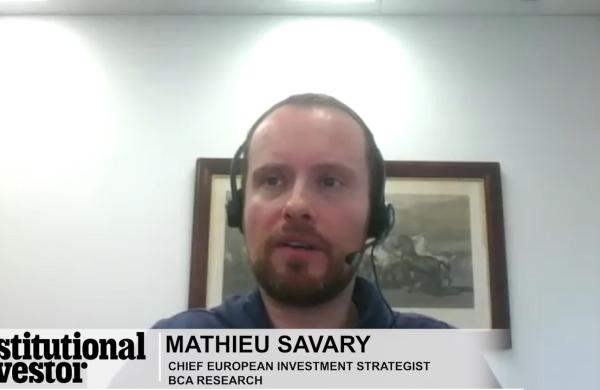Until recently, floating-rate bonds have been awfully scarce. With monetary policy unusually loose and market interest rates at historic lows, corporations seeking to raise debt capital have jumped at the chance to lock in low, fixed, long-term interest payments. And bond investors, hungry for any additional yield, have largely preferred fixed-rate issues to floaters, which typically demand lower coupon payments from corporations to compensate them for shouldering the risk that rates might move against them before the debt matures.
All that changed last year. Through December 15, corporations issued some $521.1 billion in floating-rate bonds last year, up by 64 percent from $316.9 billion in 2003, according to New York research firm Dealogic. Adjustable-rate paper acounted for 32.6 percent of all corporate issuance globally in 2004 -- up from only 15.7 percent just two years ago. It's the highest percentage since Dealogic began tracking such data in 1998 (see graph).
One big reason for the surge has been investor demand. Now that the Federal Reserve Board has begun tightening the money supply, bond buyers are more interested in hedging their exposure to rising rates, which cause existing fixed-rate bonds to decline in value.
Corporations have been willing to sate the market's hunger. Take Atlanta cable concern Cox Communications, which last month issued $500 million in three-year floating-rate debt to give its $3 billion offering -- the rest of which was fixed-rate -- wider appeal.
"Three billion dollars is a large number, and we thought it was a good opportunity to take a little bit of pressure off the deal by tapping a different investor base," says Stacey Link, the company's treasury manager.

|
| By supplying so much variable-rate paper, companies leave themselves open to unexpected macroeconomic shocks that might cause rates to rise more sharply than their current, measured pace. Should that happen, interest costs for some companies could increase dramatically, endangering everything from earnings to credit ratings. But that's a gamble that many corporate financial executives seem willing to take. San Francisco utility PG&E Corp., for instance, sold $1.6 billion in two-year floating-rate notes in March. But the company planned in advance to refinance the issue with the proceeds from a pending asset securitization rather than keep it outstanding until maturity. PG&E has already repaid $500 million of the bonds and, according to Leroy Barnes, its treasurer, expects to pay back most of the re- mainder when the securitization is completed this month. Because company officials didn't expect the bonds, which were callable at six months, to circulate for very long, they didn't worry about interest rate risk. "It's unlikely that rates will rise so much that we would have been better off with fixed-rate debt," explains Barnes. Issuers aren't alone in thinking that market rates won't rise quickly enough to saddle corporate issuers with unforeseen hikes in interest costs that are large enough to hurt their finances. John Lonski, chief economist at Moody's Investors Service, predicts that rates probably won't climb so much as to lift variable-rate borrowing costs for corporations higher than the current cost of fixed-rate borrowing. What's more, issuers have become far more adept over the years at using the derivatives market to hedge any interest rate risk they assume. Consequently, concludes Bank of America chief credit strategist Jeffrey Rosenberg, "rising rates in 2005 may not mean a rise in interest expense."
|





